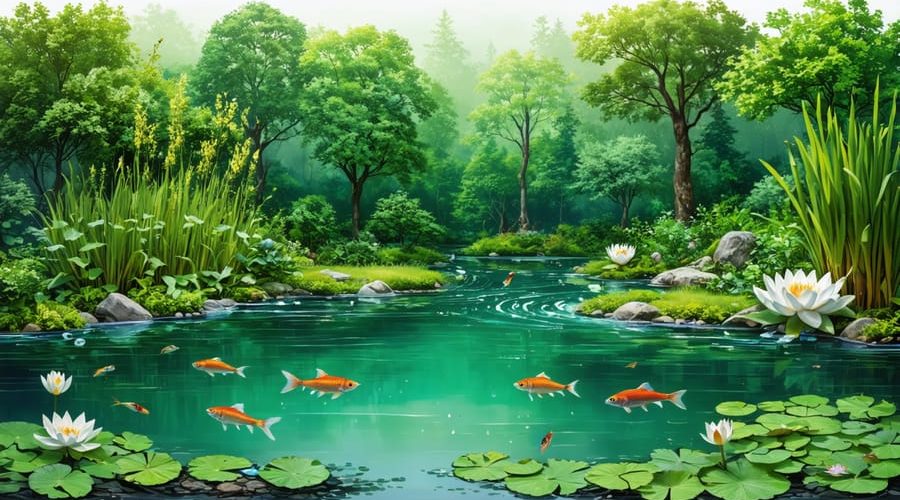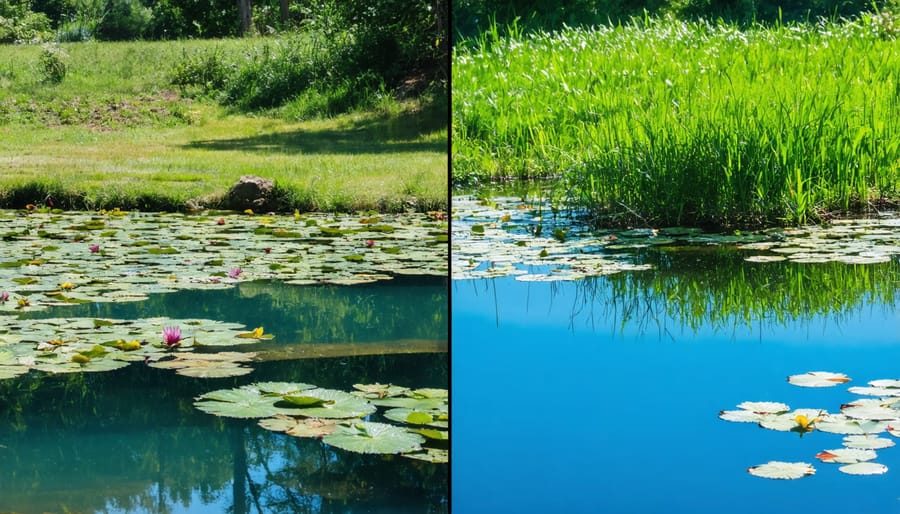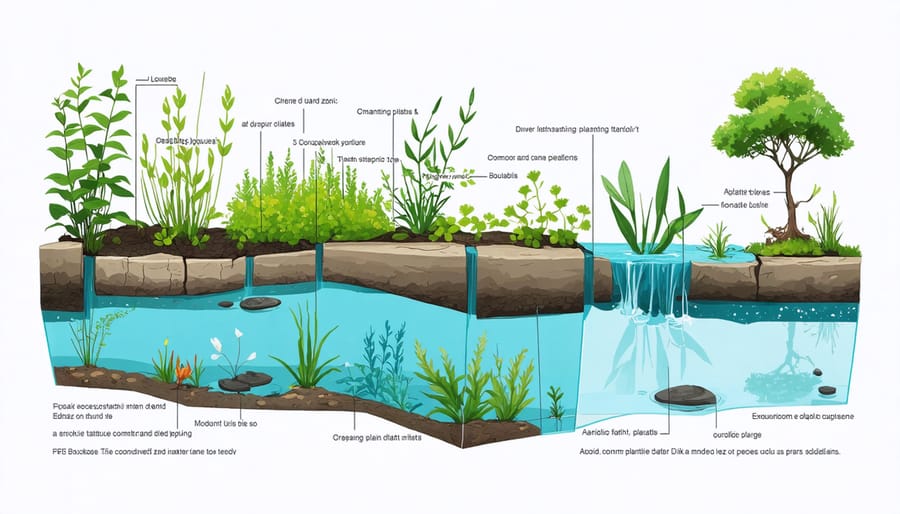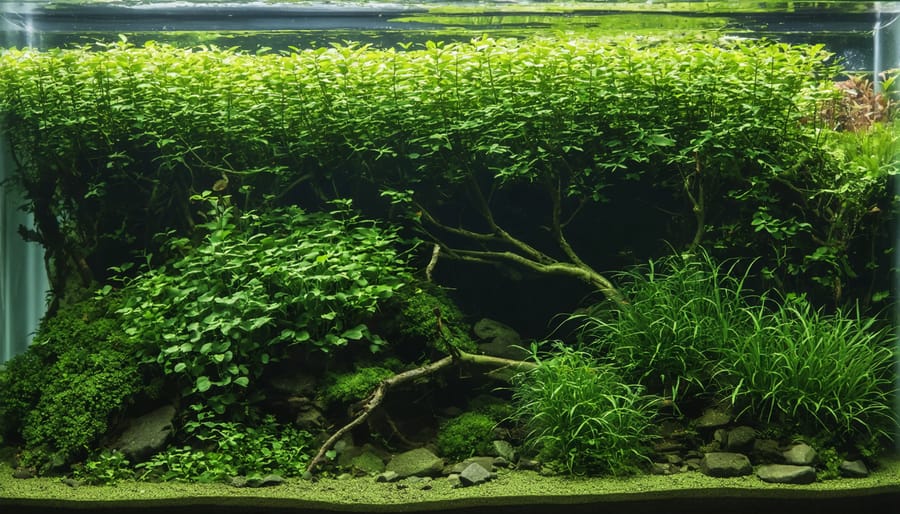
Transform Your Pond into a Self-Sustaining Ecosystem with Smart Plant Integration
Transform your aquaculture system into a sustainable powerhouse by integrating natural filtration methods, strategic fish stocking, and balanced nutrient cycling. Modern sustainable aquaculture combines traditional wisdom with cutting-edge practices, offering solutions that benefit both the environment and your bottom line. Whether you’re managing a backyard pond or a commercial operation, the key lies in creating self-sustaining ecosystems that minimize waste while maximizing production.
Sustainable aquaculture represents a crucial shift from resource-intensive farming to regenerative practices that work with nature, not against it. By implementing biofilters, maintaining optimal stocking densities, and utilizing integrated multi-trophic aquaculture (IMTA), pond owners can significantly reduce their environmental impact while improving yield quality. These methods not only enhance water quality and fish health but also create resilient systems that require fewer inputs and generate less waste.
The future of fish farming depends on our ability to develop and maintain sustainable practices that protect our water resources while meeting growing food demands. Through careful planning and implementation of proven techniques, anyone can create a thriving aquaculture system that benefits both their community and the environment.
Why Aquatic Plants Are Your Pond’s Secret Weapon

Natural Filtration Heroes
Plants are nature’s own water purification system, working tirelessly to maintain clear water in your aquaculture setup. These green heroes act like living filters, absorbing excess nutrients that would otherwise fuel algae growth. Water lilies, for example, spread their leaves across the surface, providing shade and reducing algae while their roots take up nitrogen and phosphorus from the water.
Submerged plants like hornwort and anacharis work around the clock, oxygenating the water and filtering out harmful compounds. They’re particularly effective at removing ammonia, which can be toxic to fish. Along the edges, marginal plants such as rushes and cattails create a natural barrier that traps debris and processes nutrients before they enter the main water body.
One of the most impressive natural filters is the humble water hyacinth, capable of removing heavy metals and excess nutrients from the water. Think of these plants as your pond’s cleanup crew, working 24/7 to keep your aquaculture system healthy and balanced, all while adding beauty to your setup.
Oxygen Production and Fish Health
In a thriving aquaculture system, plants play a crucial role in maintaining perfect fish and flora harmony. Through photosynthesis, aquatic plants naturally produce oxygen during daylight hours, which is essential for fish health and survival. This natural process creates a win-win situation where plants help maintain optimal oxygen levels while fish provide nutrients that feed the plants.
During sunny days, floating plants like water lilies and submerged plants such as hornwort act as natural oxygen pumps. They release oxygen directly into the water, creating oxygen-rich zones where fish can thrive. These plants also provide shelter and help reduce stress in fish, contributing to their overall well-being.
To maintain healthy oxygen levels in your pond, aim for about 60% plant coverage of your water surface. This balance ensures enough sunlight reaches deeper waters while maintaining adequate oxygen production. Remember that different seasons affect plant growth and oxygen production, so you might need to adjust your plant quantities accordingly. Keep an eye on your fish behavior – if they’re gasping at the surface, it might be time to add more oxygen-producing plants to your system.
Choosing the Right Plants for Your System

Surface Plants for Shade and Protection
Surface plants play a crucial role in creating a thriving aquaculture environment. When choosing best floating plants, consider options like water lilies, lotus, and duckweed, which provide multiple benefits for your pond ecosystem.
Water lilies are fantastic shade providers, covering up to 70% of your pond’s surface. Their broad leaves not only keep the water cool but also reduce algae growth by limiting sunlight penetration. Plus, they create perfect hiding spots for fish from predatory birds.
Duckweed, though tiny, packs a powerful punch in nutrient absorption. This fast-growing plant helps maintain water quality by removing excess nutrients that could otherwise feed unwanted algae. It’s also a natural food source for many fish species.
Lotus plants add both beauty and functionality to your pond. Their large leaves provide excellent shade while their deep roots help stabilize the pond bottom. They’re particularly effective at filtering out pollutants and creating natural barriers between different pond zones.
For smaller ponds, water lettuce and frogbit are excellent choices. These compact floaters develop extensive root systems that provide shelter for fish fry and helpful microorganisms. They’re easy to manage and can be quickly adjusted to maintain optimal coverage.
Remember to maintain about 60% surface coverage for optimal pond health, allowing enough light penetration while ensuring adequate protection and shade.
Submerged Plants for Water Quality
Submerged plants are nature’s own water filtration system, playing a crucial role in maintaining crystal-clear pond water. These remarkable plants thrive underwater while absorbing excess nutrients and providing natural competition against unwanted algae growth.
Popular varieties like Hornwort, Anacharis, and Vallisneria act as living filters, consuming nitrates and phosphates that would otherwise feed algae blooms. These underwater champions also release oxygen during daylight hours, supporting healthy fish populations and creating a balanced ecosystem.
For best results, aim to cover about 60% of your pond’s bottom with submerged plants. Start with 1-2 bunches per square meter, allowing them to establish naturally. Plant them in weighted mesh baskets filled with aquatic soil, or simply anchor them to the bottom with plant weights.
Remember to trim these plants regularly during the growing season to prevent overcrowding. The trimmed portions make excellent natural fertilizer for your garden! As a bonus, these plants provide shelter for fish fry and valuable hiding spots for smaller pond inhabitants.
To maintain their effectiveness, remove any yellowing or dying leaves promptly, and divide overcrowded plants in spring. This simple maintenance routine will keep your underwater garden thriving while ensuring excellent water quality year-round.
Plant Integration Made Simple
Planting Techniques That Work
Ready to get your aquatic plants thriving? Let’s dive into proven planting techniques that will help establish a healthy water garden. Start by selecting plants that match your pond’s depth zones – shallow marginals near the edges, deep-water plants in the center, and floating varieties on the surface.
For potted plants, use heavy clay-based aquatic soil and avoid regular garden soil which can cloud your water. Place larger stones on top of the soil to prevent fish from disturbing the plants. When planting, keep the crown (where stems meet roots) at soil level and gently firm the soil around roots.
For marginal plants, position them on shelves or in shallow areas where water covers the soil by 1-2 inches. Deep-water plants should be lowered gradually over several days to help them adjust to depth changes. Floating plants can simply be placed on the water’s surface – they’ll naturally spread as they grow.
Remember to space plants appropriately – about 2-3 feet apart for most varieties. This gives them room to grow while maintaining good water circulation. During the first few weeks, check plants regularly and adjust their positions if needed.

Seasonal Care Tips
Maintaining a sustainable aquaculture system requires adapting your care routine to each season’s unique challenges. In spring, focus on gradually increasing fish feeding as temperatures rise and checking filtration systems after winter dormancy. Test water parameters weekly during this transition period to ensure stability.
Summer demands extra attention to oxygen levels, especially during hot spells. Add floating plants to provide shade and natural cooling, while maintaining regular water top-offs to compensate for increased evaporation. Monitor ammonia levels closely when fish are most active and feeding heavily.
As autumn approaches, begin reducing feed portions and remove falling leaves promptly to prevent excess organic matter buildup. Install pond netting early to catch leaves before they sink. This is also the ideal time to trim back aquatic plants and remove excess growth.
Winter care centers on protecting your system from freezing. If you’re in a cold climate, consider installing a de-icer to maintain a small opening in the ice for gas exchange. Reduce or stop feeding when temperatures consistently drop below 50°F (10°C), as fish naturally enter a period of dormancy. Regular ice monitoring and gentle snow removal from frozen surfaces help maintain light penetration for essential photosynthesis.
Common Challenges and Solutions
Plant Growth Control
Maintaining the right balance of plants in your aquaculture system is crucial for long-term sustainability. While plants play a vital role in filtering water and providing oxygen, their growth needs careful management to prevent them from taking over your pond or system.
Start by implementing a regular maintenance schedule to trim and thin out fast-growing plants. Water hyacinths and duckweed, for instance, can double their population in just a few days under ideal conditions. Remove about 30% of floating plants weekly during peak growing seasons to maintain proper coverage.
For rooted plants, consider using bottom barriers or planting baskets to contain their spread. This is especially helpful for aggressive species like cattails or water lilies. When choosing plants, opt for a mix of different growth rates – some fast-growing species for quick nutrient removal, balanced with slower-growing varieties for long-term stability.
Natural control methods work best for sustainable systems. Consider adding herbivorous fish like grass carp, but be careful with the numbers – too many can completely eliminate your beneficial plants. Another eco-friendly approach is to reduce nutrient levels by not overfeeding fish and regularly removing debris from the bottom.
Remember that seasonal changes affect plant growth rates. What works in summer might need adjusting in spring or fall. Keep a close eye on water quality parameters, as they’ll help you gauge whether your plant management strategy is working effectively.
Troubleshooting Plant Health
Just like any garden, aquatic plants can face various health challenges. The key to maintaining healthy plants is spotting problems early and taking swift action. Yellowing leaves often indicate nutrient deficiencies – typically iron or nitrogen. If you notice this, consider testing your water parameters and adjusting your fertilization routine accordingly.
Algae competition is another common issue. When plants appear stunted or covered in green film, they’re likely struggling to compete with algae for nutrients. Reducing direct sunlight exposure and adding floating plants can help restore balance. Brown or mushy leaves usually signal rot, which requires immediate removal of affected parts to prevent spread.
Watch out for common pests like aphids and spider mites, which can attack even aquatic plants. A gentle spray of water can dislodge these insects, or you might introduce beneficial insects like ladybugs for natural control. Poor plant growth could also result from incorrect planting depth – make sure each species is planted at its preferred level.
If leaves develop holes or appear tattered, check for fish nibbling on them. Some fish species love snacking on plants, so you might need to protect vulnerable specimens with barriers or choose more resistant varieties. Remember that seasonal changes are normal – many aquatic plants naturally die back in winter and regrow in spring.
Regular monitoring and quick response to these issues will help maintain a thriving aquatic garden.
As we’ve explored throughout this guide, sustainable aquaculture practices aren’t just good for the environment – they’re essential for creating thriving, long-lasting pond ecosystems. By implementing natural filtration methods, choosing the right fish populations, and maintaining proper water quality, you’re not only creating a beautiful water feature but also contributing to a healthier planet.
Remember, starting small is perfectly fine. Perhaps begin with adding some native aquatic plants or setting up a simple biofilter. As you become more comfortable, you can gradually incorporate more sustainable practices into your pond management routine. The key is to make consistent progress rather than trying to transform everything overnight.
The benefits of sustainable aquaculture extend far beyond your backyard. You’ll save money on maintenance costs, enjoy clearer water, healthier fish, and fewer algae problems. Plus, you’ll create a wonderful habitat for local wildlife, from dragonflies to birds, making your pond a true ecosystem.
We encourage you to take that first step today. Whether it’s researching native plants for your area, testing your water quality, or planning a natural filtration system, every small action counts. With patience and dedication, you’ll soon have a sustainable pond that brings joy for years to come while supporting our environment’s health.
Together, we can make pond keeping more sustainable, one water garden at a time!
